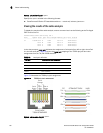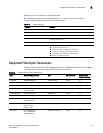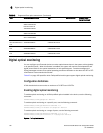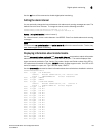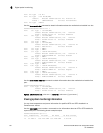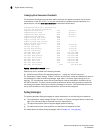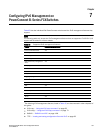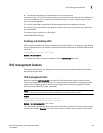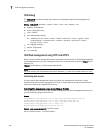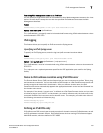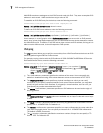
PowerConnect B-Series FCX Configuration Guide 195
53-1002266-01
Digital optical monitoring
6
Normal Normal Normal Normal
Syntax: show optic <port-number>
NOTE
The show optic function takes advantage of information stored and supplied by the manufacturer of
the XFP or SFP transceiver. This information is an optional feature of the Multi-Source Agreement
standard defining the optical interface. Not all component suppliers have implemented this feature
set. In such cases where the XFP or SFP transceiver does not supply the information, a “Not
Available” message will be displayed for the specific port on which the module is installed.
The following table describes the information displayed by the show optic command.
For Temperature, Tx Power, Rx Power, and Tx Bias Current in the show optic command output,
values are displayed along with one of the following alarm status values: Low-Alarm, Low-Warn,
Normal, High-Warn or High-Alarm. The thresholds that determine these status values are set by the
manufacturer of the optical transceivers. Table 44 describes each of these status values.
TABLE 43 Output from the show optic command
This field... Displays...
Port The Dell port number.
Temperature
• The operating temperature, in degrees Celsius, of the optical
transceiver.
• The alarm status, as described in Table 44.
Tx Power
• The transmit power signal, in decibels (dB), of the measured power
referenced to one milliwatt (mW).
• The alarm status, as described in Table 44.
Rx Power
• The receive power signal, in decibels (dB), of the measured power
referenced to one milliwatt (mW).
• The alarm status, as described in Table 44
Tx Bias Current
• The transmit bias power signal, in milliamperes (mA).
• The alarm status, as described in Table 44.
TABLE 44 Alarm status value description
Status value Description
Low-Alarm Monitored level has dropped below the "low-alarm" threshold set by the manufacturer of the
optical transceiver.
Low-Warn Monitored level has dropped below the "low-warn" threshold set by the manufacturer of the
optical transceiver.
Normal Monitored level is within the "normal" range set by the manufacturer of the optical transceiver.
High-Warn Monitored level has climbed above the "high-warn" threshold set by the manufacturer of the
optical transceiver.
High-Alarm Monitored level has climbed above the "high-alarm" threshold set by the manufacturer of the
optical transceiver.






